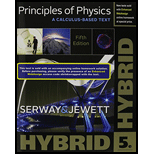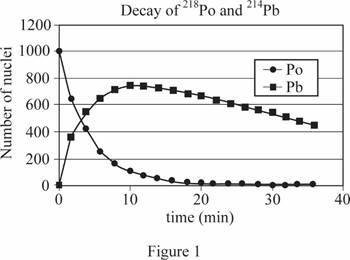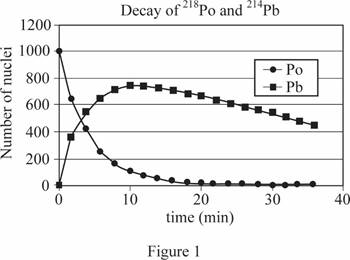
Concept explainers
(a)
The differential equation that defines the number of daughter nucleus.
(a)
Answer to Problem 20P
The daughter nucleus satisfies the differential equation is
Explanation of Solution
Let
Write the expression for decay rate
Here,
Write the expression for rate of change of the daughter nuclei
Here,
The rate of decay of the parent nucleus is same as the rate of production of the daughter nuclei.
Substitute
Conclusion:
Substitute
Thus, the daughter nucleus satisfies the differential equation is
(b)
The solution to the above differential equation using the verification by substitution method.
(b)
Answer to Problem 20P
Explanation of Solution
Write the expression for trail solution
Differentiate the above equation with respect to
Multiply equation (V) by
Write the expression for
Conclusion:
Solve (VII) further
Substitute (VIII) in the above equation and rearrange.
Thus,
(c)
The number of
(c)
Answer to Problem 20P
The number of

Explanation of Solution
Write the expression for decay constant
Here,
Substitute
Substitute
Substitute
Substitute
Conclusion:
Using expression (X) and (XI), table the number of
| 0 | 1000 | 0 |
| 2 | 445 | 350 |
| 4 | 408 | 557 |
| 6 | 261 | 673 |
| 8 | 167 | 730 |
| 10 | 107 | 752 |
| 12 | 68.3 | 751 |
| 14 | 43.7 | 737 |
| 16 | 27.9 | 715 |
| 18 | 17.9 | 689 |
| 20 | 11.4 | 660 |
| 22 | 7.30 | 631 |
| 24 | 4.67 | 602 |
| 26 | 2.99 | 573 |
| 28 | 1.91 | 545 |
| 30 | 1.22 | 519 |
| 32 | 0.781 | 493 |
| 34 | 0.499 | 468 |
| 36 | 0.319 | 445 |
Using the above data in the table construct the graph

Thus, the above graph shows the number of nuclei as a function of time.
(d)
The instant when the number of
(d)
Answer to Problem 20P
The number of
Explanation of Solution
From the above graph, the
(e)
An expression for maximum number of
(e)
Answer to Problem 20P
The time for maximum
Explanation of Solution
Equate (VI) to zero to find the maximum
Conclusion:
Simplify and rearrange for
Here,
Thus, time for maximum
(f)
The instant when the number of
(f)
Answer to Problem 20P
The time when the number of
Explanation of Solution
The time for maximum
Conclusion:
Substitute
Thus, the time when the number of
Want to see more full solutions like this?
Chapter 30 Solutions
Principles of Physics: A Calculus-Based Text, Hybrid (with Enhanced WebAssign Printed Access Card)
- 8. With the aid of a diagram draw the following electric circuit and use the resistor as the load, (a) Closed circuit (b) Open circuitarrow_forwardLab 8 Part 3 PHET Wave Interface simulation. I am having trouble with this part of the lab.arrow_forwardMick and Rick are twins born on Earth in the year 2175. Rick grows up to be an Earth-bound robotics technician while Mick becomes an intergalactic astronaut. Mick leaves the Earth on his first space mission in the year 2200 and travels, according to his clock, for 10 years at a speed of 0.75c. Unfortunately, at this point in his journey, the structure of his ship undergoes mechanical breakdown and the ship explodes. How old is Rick when his brother dies?arrow_forward
 Modern PhysicsPhysicsISBN:9781111794378Author:Raymond A. Serway, Clement J. Moses, Curt A. MoyerPublisher:Cengage Learning
Modern PhysicsPhysicsISBN:9781111794378Author:Raymond A. Serway, Clement J. Moses, Curt A. MoyerPublisher:Cengage Learning Principles of Physics: A Calculus-Based TextPhysicsISBN:9781133104261Author:Raymond A. Serway, John W. JewettPublisher:Cengage Learning
Principles of Physics: A Calculus-Based TextPhysicsISBN:9781133104261Author:Raymond A. Serway, John W. JewettPublisher:Cengage Learning Physics for Scientists and Engineers with Modern ...PhysicsISBN:9781337553292Author:Raymond A. Serway, John W. JewettPublisher:Cengage Learning
Physics for Scientists and Engineers with Modern ...PhysicsISBN:9781337553292Author:Raymond A. Serway, John W. JewettPublisher:Cengage Learning University Physics Volume 3PhysicsISBN:9781938168185Author:William Moebs, Jeff SannyPublisher:OpenStax
University Physics Volume 3PhysicsISBN:9781938168185Author:William Moebs, Jeff SannyPublisher:OpenStax College PhysicsPhysicsISBN:9781285737027Author:Raymond A. Serway, Chris VuillePublisher:Cengage Learning
College PhysicsPhysicsISBN:9781285737027Author:Raymond A. Serway, Chris VuillePublisher:Cengage Learning College PhysicsPhysicsISBN:9781938168000Author:Paul Peter Urone, Roger HinrichsPublisher:OpenStax College
College PhysicsPhysicsISBN:9781938168000Author:Paul Peter Urone, Roger HinrichsPublisher:OpenStax College





